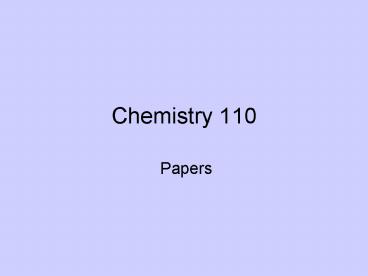Chemistry 110 - PowerPoint PPT Presentation
1 / 24
Title:
Chemistry 110
Description:
Any chemist anywhere in the world should be able to repeat ... Books: Day, R. How to Write and Publish a Scientific Paper; Oryx Press: Phoenix, 1998, pp 1-10. ... – PowerPoint PPT presentation
Number of Views:56
Avg rating:3.0/5.0
Title: Chemistry 110
1
Chemistry 110
- Papers
2
Primary Literature
- Primary - first publication of research which
includes complete description of experimental
work and results. Any chemist anywhere in the
world should be able to repeat and verify the
experimental results from the given description - Provides opportunity for peer review
3
Secondary Literature
- Some type of compilation or summary of the
contents of primary literature - Original experiments cannot be repeated since it
does not provide experimental details
4
Review Paper
- Review paper is a detailed summary of the primary
literature published on a specific topic over a
defined period of time - It is secondary literature which collects a large
amount of related material in one place
5
Uses of Reviews
- To obtain background in areas with which a person
is unfamiliar - To obtain references to the original literature
on a topic
6
Types of Reviews
- Critical and selective - evaluative review of a
selection of published works - not
bibliographically complete but provides an
assessment - invited authority - Comprehensive (descriptive) - summar-izes all
relevant work published in a given period of time
-bibliographically complete but without
evaluation (Chem 110)
7
Style of a Review Paper
- Written for a general audience
- Avoids jargon and specialized abbreviations or,
if used, fully explains them on first encounter
8
Review Paper for Chem 110
- 10-20 pages
- Due 4/26/05
- Comprehensive without assessment
- Cover the period since the last review article on
the topic or cover all publications in a narrowly
defined sub-topic
9
Selection of Topic
- Independent study research interests
- Professor
- Something that interests you
- See sample review papers prepared by previous
students in Chem 110 in External Links on
Blackboard
10
Structure of Review Paper
- Outline of Contents of Review Paper
- Introduction which includes discussion of
literature search, Acronyms list, Useful web
sites, earlier reviews - Organized Summary of Information Found
- Conclusion
- Literature Cited
11
Method of Literature Search
- Manual, computer-based or both?
- Name bibliographic databases searched
- Earliest and latest dates covered
- Criteria for selecting articles
- See Anal. Chem. 2002, 74, 2719-2742
(http//pubs.acs.org/journals/ancham/article.cgi/a
ncham/2002/74/i12/html/ac020211h.html)
12
Results of Search
- Summarize all the relevant publications
objectively - Provide an organizational framework
- See Chem. Rev., 1999, 99, 2071-2083
(http//pubs.acs.org/journals/chreay/article.cgi/c
hreay/1999/99/i08/html/cr980032t.html)
13
Style of Documentation
- "In order to meet the requirements of academic
honesty, all quotes, paraphrases, and summaries
must be cited in both the text of the paper and
in a reference list at the end of your paper. The
citation within the text of the paper should lead
readers to a full bibliographic citation in your
reference list. " - Chem 110 uses ACS Documentation
Stylehttp//iws.ohiolink.edu/chemistry/info/acs.h
tml
14
In-Text Citations by Number
- Following a paraphrase, quote, or summary, place
a sequential number in parentheses such as (1) - Begin with 1 and then number each reference
consecutively - For detail, see http//iws.ohiolink.edu/chemistry/
info/acs.html
15
References at End of Text
- "Put a reference list at the end of the paper in
numerical order if references were cited by
number . . . - Include complete and accurate information.
- The minimum amount of information required for
book and journal sources varies." - For details see http//iws.ohiolink.edu/chemistry/
info/acs.html
16
Conclusion
- Summarize main findings
- Recommend directions for new research
- See Chem. Rev., 1999, 99, 2071-2083
(http//pubs.acs.org/journals/chreay/article.cgi/c
hreay/1999/99/i08/html/cr980032t.html)
17
Reference list
- Extensive
- Accurate
- Cross check all citations and reference list
- See Chem. Rev., 1999, 99, 2071-2083
(http//pubs.acs.org/journals/chreay/article.cgi/c
hreay/1999/99/i08/html/cr980032t.html)
18
Short Paper
- 3-5 pages
- Due 3/29/05
- Select a secondary source not covered in lectures
in Chem 110 - See sample short papers (library guides) prepared
by previous students in Chem 110 in External
Links on Blackboard
19
Contents of Short Paper
- Kinds of information/data in source
- How arranged
- Manual searching technique
- Computer-based searching technique
- Students exchange, try, revise
- Final version written in HTML
- Posted to library web site
20
Course Grades
- Review paper - 60
- Short paper - 20
- Class participation - 20
21
(No Transcript)
22
Format for References
- Journal Gopen, G.D. Swan, J.A. American
Scientist 1990, 78(6), pp 550-558. - Books Day, R. How to Write and Publish a
Scientific Paper Oryx Press Phoenix, 1998, pp
1-10.
23
Format for References
- Books with editor ACS Style Guide A Manual for
Authors and Editors, 2nd ed. Dodd, J.S., Ed.
American Chemical Society Washington, DC, 1997,
pp 108-111
24
Format for References
- Web Sites Bonk, J.F. Chemistry 373 Available
from http//www.chem.duke.edu/bonk/Chem373/C
hem373MENU.html. Accessed 27 August 2001.































